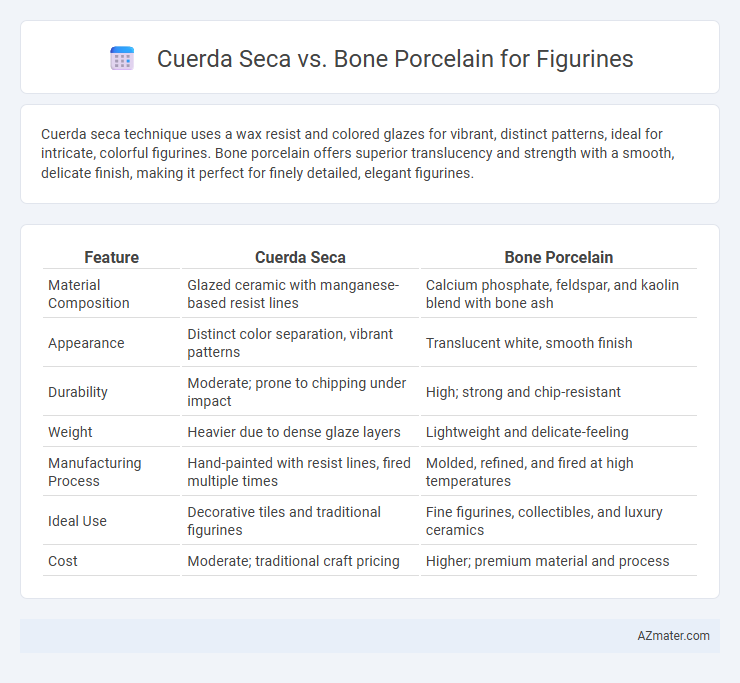Cuerda seca technique uses a wax resist and colored glazes for vibrant, distinct patterns, ideal for intricate, colorful figurines. Bone porcelain offers superior translucency and strength with a smooth, delicate finish, making it perfect for finely detailed, elegant figurines.
Table of Comparison
| Feature | Cuerda Seca | Bone Porcelain |
|---|---|---|
| Material Composition | Glazed ceramic with manganese-based resist lines | Calcium phosphate, feldspar, and kaolin blend with bone ash |
| Appearance | Distinct color separation, vibrant patterns | Translucent white, smooth finish |
| Durability | Moderate; prone to chipping under impact | High; strong and chip-resistant |
| Weight | Heavier due to dense glaze layers | Lightweight and delicate-feeling |
| Manufacturing Process | Hand-painted with resist lines, fired multiple times | Molded, refined, and fired at high temperatures |
| Ideal Use | Decorative tiles and traditional figurines | Fine figurines, collectibles, and luxury ceramics |
| Cost | Moderate; traditional craft pricing | Higher; premium material and process |
Introduction to Figurine Crafting Techniques
Cuerda seca and bone porcelain represent two distinct figurine crafting techniques with unique aesthetic and material properties. Cuerda seca involves using colored slip separated by thin lines of manganese oxide to create intricate patterns on ceramics, offering rich visual texture and durability. Bone porcelain, made from refined kaolin, feldspar, and bone ash, provides a translucent, delicate finish ideal for lifelike figurines prized for their smooth surface and fine detail.
What is Cuerda Seca?
Cuerda seca is a traditional ceramic technique originating from Spain and Mexico, characterized by using oily lines to separate different colored glazes, preventing them from mixing during firing. This method creates vibrant, distinct patterns ideal for decorative figurines, enhancing their visual appeal with intricate, multi-colored designs. Unlike bone porcelain, which is prized for its translucency and smooth texture, cuerda seca emphasizes bold, colorful surface decoration, making it a unique choice for artistic ceramic figurines.
Understanding Bone Porcelain
Bone porcelain offers superior strength and translucency due to its high bone ash content, making it ideal for detailed figurines requiring durability and fine craftsmanship. Unlike cuerda seca, a decorative technique involving colored slips and resist lines typically used in tile work, bone porcelain's smooth and delicate texture allows for intricate sculptural expressions. Collectors and artists prefer bone porcelain figurines for their refined finish, light weight, and resistance to chipping compared to cuerda seca's more rustic and patterned aesthetic.
Historical Background of Cuerda Seca and Bone Porcelain
Cuerda seca, a technique developed in the 10th century Muslim Spain, involves using greasy lines to separate colors in ceramic glazing, creating intricate and durable designs often seen in tiles and figurines. Bone porcelain, invented in 18th century England by Josiah Spode, incorporates bone ash to produce a strong, translucent material prized for its fine, smooth texture and elegant finish in figurines and tableware. Both methods reflect distinct cultural histories and craftsmanship, with cuerda seca emphasizing detailed, multi-colored patterns and bone porcelain focusing on material purity and refinement.
Differences in Material Composition
Cuerda seca figurines are created using a resist technique where colored glazes are separated by a greasy substance, producing intricate lines and patterns on ceramic surfaces, primarily clay-based. Bone porcelain, composed of kaolin, feldspar, quartz, and bone ash, offers a denser, more translucent quality with superior strength and a smoother texture compared to the more porous stoneware of cuerda seca. The fundamental difference lies in the raw materials: cuerda seca relies on traditional clay and glaze separation methods, while bone porcelain incorporates bone ash, enhancing durability and luminosity in figurine artistry.
Durability and Longevity Comparison
Cuerda seca figurines typically feature vibrant, multi-colored glazes separated by thin wax lines, which can be more susceptible to chipping and wear over time compared to bone porcelain. Bone porcelain offers superior durability and longevity due to its high-density composition and firing process, resulting in a stronger, less porous surface resistant to cracks and fading. Collectors often prefer bone porcelain for its ability to maintain pristine condition over decades, making it a more resilient choice for long-term display.
Visual Aesthetics: Color and Finish
Cuerda seca technique on figurines delivers vibrant, distinct color separation with sharp outlines, creating a visually striking and intricate finish that enhances ornamental details. Bone porcelain offers a smooth, translucent surface with subtle color gradation and a glossy finish that provides a refined, elegant appearance. The choice between these materials impacts visual aesthetics significantly, with cuerda seca emphasizing bold, graphic patterns and bone porcelain highlighting delicate, realistic hues and a luminous texture.
Detailing and Artistic Possibilities
Cuerda seca technique offers vibrant color segmentation and sharp outlines, enhancing intricate detailing in figurines, while bone porcelain provides a smooth, translucent surface ideal for subtle shading and realistic textures. The porous nature of bone porcelain allows for fine sculptural details and lifelike finishes that cuerda seca's bold color separation cannot replicate. Artists often choose cuerda seca for vivid, graphic designs, whereas bone porcelain excels in delicate modeling and soft, nuanced artistic expressions.
Cost Implications and Accessibility
Cuerda seca figurines, known for their intricate, hand-painted ceramic designs, often incur higher production costs due to labor-intensive processes and specialized materials compared to bone porcelain, which benefits from mass production techniques and widespread availability. Bone porcelain figurines offer greater affordability and accessibility in the market, making them a popular choice for collectors seeking quality at lower prices. Cost implications favor bone porcelain as a budget-friendly option, while cuerda seca appeals to niche collectors valuing artisanal craftsmanship despite higher expenses.
Choosing the Right Material for Figurine Creation
Cuerda seca offers vibrant, multi-colored patterns ideal for intricate, decorative figurines, while bone porcelain provides a smooth, translucent finish known for its strength and elegance. Selecting the right material depends on the desired aesthetic: cuerda seca suits bold, colorful designs, whereas bone porcelain favors refined, delicate details. Consider durability requirements and firing techniques since bone porcelain requires higher kiln temperatures, impacting production cost and fragility.

Infographic: Cuerda seca vs Bone porcelain for Figurine
 azmater.com
azmater.com